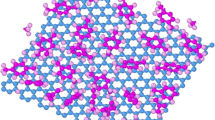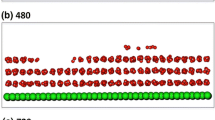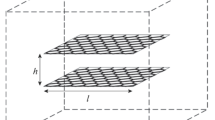Abstract
Weak interactions of graphene surface with reactive molecular impurities are the subject of many studies since noncovalent functionalization of surface via molecular doping is a powerful tool for tuning the electronic properties of graphene layers. In this work, the adsorption of diatomic halogen gas molecules, F2, Cl2, Br2, I2 onto bilayer and multilayer pristine graphene surfaces were studied comparatively by Monte Carlo (MC) and molecular dynamics (MD) simulation techniques in canonical ensemble. The adsorption sites, adsorption capacity, coverage factors, adsorption isotherms, and adsorption kinetics were investigated and the adsorption energies were calculated for all adsorbates. Graphene was modeled as a two-dimensional layer of 200 carbon atoms in a honeycomb arrangement. The COMPASS force field was used in the simulations. The adsorption isotherms were obtained and fitted to Langmuir model. The kinetics of adsorption was studied and found to be first order. Both the monolayer and the multilayer adsorption of halogen molecules showed that van der Waals volumes of halogen molecules and also their polarizabilities display a competitive role in the saturation capacity and the strength of surface interactions.






Similar content being viewed by others
Abbreviations
- BLG:
-
Bilayer graphene
- MD:
-
Molecular Dynamics
- MC:
-
Monte Carlo
- XRD:
-
X-ray diffraction
- DFT:
-
Density functional theory
References
Geim AK, Novoselov KS (2007) The rise of graphene. Nat Mater 6(3):183–191
Lee C, Wei X, Kysar JW, Hone J (2008) Measurement of the elastic properties and intrinsic strength of monolayer graphene. Science 321(5887):385–388
Fowler JD, Allen MJ, Tung VC, Yang Y, Kaner RB, Weiller BH (2009) Practical chemical sensors from chemically derived graphene. ACS Nano 3(2):301–306
Kong J, Franklin NR, Zhou C, Chapline MG, Peng S, Cho K et al. (2000) Nanotube molecular wires as chemical sensors. Science 287(5453):622–625
Lee SM, Lee YH (2000) Hydrogen storage in single-walled carbon nanotubes. Appl Phys Lett 76(20):2877–2879
Zhu XY, Lee SM, Lee YH, Frauenheim T (2000) Adsorption and desorption of an O2 molecule on carbon nanotubes. Phys Rev Lett 85(13):2757–2760
Jhi SH, Louie SG, Cohen ML (2000) Electronic properties of oxidized carbon nanotubes. Phys Rev Lett 85(8):1710–1713
Chang H, Lee JD, Lee SM, Lee YH (2001) Adsorption of NH3 and NO2 molecules on carbon nanotubes. Appl Phys Lett 79:3863–3865
Zhao J, Buldum A, Han J, Lu JP (2002) Gas molecule adsorption in carbon nanotubes and nanotube bundles. Nanotechnol 13(2):195–213
Leenaerts O, Partoens B, Peeters FM (2008) Adsorption of H2O, NH3, CO, NO2, and NO on graphene: a first-principles study. Phys Rev B 77(12):125416–125421
Chen S, Cai W, Chen D, Ren Y, Li X, Zhu Y et al. (2010) Adsorption/desorption and electrically controlled flipping of ammonia molecules on graphene. New J Phys 12(12):125011–125023
Schedin F, Geim AK, Morozov SV, Hill EW, Blake P, Katsnelson MI et al. (2007) Detection of individual gas molecules adsorbed on graphene. Nat Mater 6(9):652–655
Robinson JA, Snow ES, Badescu SC, Reinecke TL, Perkins FK (2006) Role of defects in single-walled carbon nanotube chemical sensors. Nano Lett 6(8):1747–1751
Widenkvist E, Boukhvalov DW, Rubino S, Akhtar S, Lu J, Quinlan RA et al. (2009) Mild sonochemical exfoliation of bromine-intercalated graphite: a new route towards graphene. J Phys D: Appl Phys 42(11):112003–112012
Politzer P, Murray JS, Clark T (2015) σ-Hole bonding: a physical interpretation. Top Curr Chem 358:19–42
Watanabe N, Takenaka H, Takashima M (1973) Adsorption of fluorine on graphite. Nippon Kagaku Kaishi 3:487–490
Politzer P, Murray JS (2013) Halogen bonding: an interim discussion. Chem Phys Chem 14(2):278–294
Politzer P, Murray JS, Clark T (2015) Mathematical modeling and physical reality in noncovalent interactions. J Mol Model 21(3):1–10
Sütay B, Yurtsever M, Yurtsever E (2014) A post-HF study on the interaction of iodine with small polyaromatic hydrocarbons. J Mol Model 20(10):1–10
Sütay B, Yurtsever M, Yurtsever E (2016) A post‐HF study on the halogen bonding interaction of pyrene with diatomic halogen molecules. Int J Quantum Chem 116:702–709
Medeiros PVC, Mascarenhas AJS, de Brito MF, de Castilho CMC (2010) A DFT study of halogen atoms adsorbed on graphene layers. Nanotechnol 21:485701–485708
Auffinger P, Hays FA, Westhof E, Ho PS (2004) Halogen bonds in biological molecules. Proc Natl Acad Sci U S A 101(48):16789–16794
Metrangolo P, Neukirch H, Pilati T, Resnati G (2005) Halogen bonding based recognition processes: a world parallel to hydrogen bonding. Acc Chem Res 38(5):386–395
Imakubo T, Sawa H, Kato R (1995) Novel radical cation salts of organic π-donors containing iodine atom(s): the first application of strong intermolecular-I · · · X-(X = CN, halogen atom) interaction to molecular conductors. Synth Met 73(2):117–122
Amico V, Meille SV, Corradi E, Messina MT, Resnati G (1998) Perfluorocarbon-hydrocarbon self-assembling. 1D infinite chain formation driven by nitrogen…iodine interactions. J Am Chem Soc 120(32):8261–8262
Goikoetxea I, Juaristi JI, Alducin M, Muiño RD (2009) Dissipative effects in the dynamics of N2 on tungsten surfaces. J Phys: Condens Matter 21(26):264007–264018
Alducin M, Muiño RD, Busnengo HF, Salin A (2006) Why N2 molecules with thermal energy abundantly dissociate on W (100) and not on W (110). Phys Rev Lett 97(5):056102–056105
Juaristi JI, Alducin M, Muiño RD, Busnengo HF, Salin A (2008) Role of electron-hole pair excitations in the dissociative adsorption of diatomic molecules on metal surfaces. Phys Rev Lett 100(11):116102–116105
Wang Z, Qin S, Wang C, Hui Q (2015) Fluorine adsorption on the graphene films: from metal to insulator. Comput Mater Sci 97:14–19
Junkermeier CE, Reinecke TL, Badescu SC (2013) Highly fluorinated graphene. Condens Matter No. arXiv:1302.6878.
Zhou S, Sherpa SD, Hess DW, Bongiorno A (2014) Chemical bonding of partially fluorinated graphene. J Phys Chem C 118(45):26402–26408
Lepetit B, Lemoine D, Medina Z, Jackson B (2011) Sticking and desorption of hydrogen on graphite: a comparative study of different models. J Chem Phys 134(11):114705–114714
Davidson ER, Klimes J, Alfe D, Michaelides A (2014) Cooperative interplay of van der Waals forces and quantum nuclear effects on adsorption: H at graphene and at coronene. ACS Nano 8(10):9905–9913
Pykal M, Jurečka P, Karlický F, Otyepka M (2016) Modelling of graphene functionalization. Phys Chem Chem Phys 18(9):6351–6372
Shih CJ, Lin S, Strano MS, Blankschtein D (2010) Understanding the stabilization of liquid-phase-exfoliated graphene in polar solvents: molecular dynamics simulations and kinetic theory of colloid aggregation. J Am Chem Soc 132(41):14638–14648
Xu C, Brown PA, Lu J, Shuford KL (2015) Electronic properties of halogen-adsorbed graphene. J Phys Chem C 119(30):17271–17277
Chu SW, Baek SJ, Kim DC, Seo S, Kim JS, Park YW (2012) Charge transport in graphene doped with diatomic halogen molecules (I2, Br2) near Dirac point. Synth Met 162(17):1689–1693
Nemnes GA, Visan C, Anghel DV, Manolescu A (2016) Molecular dynamics of halogenated graphene-hexagonal boron nitride nanoribbons. J Phys Conf Ser 738(1):012027–012032
Ma LP, Wu ZS, Li J, Wu ED, Ren WC, Cheng HM (2009) Hydrogen adsorption behavior of graphene above critical temperature. Int J Hydrogen Energy 34(5):2329–2332
Kharatha M, Vaez A, Rozatian ASH (2013) Molecular dynamics simulation of gas adsorption on defected graphene. Mol Phys 111(24):3726–3732
Accelrys Inc. (2009) Accelrys Material Studio release 5.0. Accelrys software Inc., San Diego
Toukmaji AY, Board JA (1996) Ewald summation techniques in perspective: a survey. Comput Phys Commun 95(2):73–92
Nosé S (1984) A unified formulation of the constant temperature molecular dynamics methods. J Chem Phys 81(1):511–519
Wolfram Research Inc. (2016) Mathematica, version 11.0. Wolfram Research Inc., Champaign, IL
Aranovich G, Donohue M (1998) Analysis of adsorption isotherms: lattice theory predictions, classification of isotherms for gas–solid equilibria, and similarities in gas and liquid adsorption behavior. J Colloied Interface Sci 200(2):273–290
Nicholson D, Parsonage NG (1982) Computer simulation and the statistical mechanics of adsorption. Academic, Norwich
Weber SE, Talapatra S, Journet C, Zambano A, Migone AD (2000) Determination of the binding energy of methane on single-walled carbon nanotube bundles. Phys Rev B 61(19):13150–13154
Watanabe N, Nakajima T, Touhara H (1988) Graphite fluorides. Elsevier, New York
Tristant D, Puech P, Gerber IC (2015) Theoretical study of graphene doping mechanism by iodine molecules. J Phys Chem C 119(21):12071–12078
D’Arsié L, Esconjauregui S, Weatherup R, Guo Y, Bhardwaj S, Centeno A et al. (2014) Stability of graphene doping with MoO3 and I2. Appl Phys Lett 105(10):103103–103112
Rudenko AN, Keil FJ, Katsnelson MI, Lichtenstein AI (2010) Adsorption of diatomic halogen molecules on graphene: a van der Waals density functional study. Phys Rev B 82(3):035427–035434
Doll K, Harrison NM (2001) Theoretical study of chlorine adsorption on the Ag (111) surface. Phys Rev B 63(16):165410–165429
Doll K, Harrison NM (2000) Chlorine adsorption on the Cu (111) surface. Chem Phys Lett 317(3):282–289
Altarawneh M, Saraireh SA (2014) Theoretical insight into chlorine adsorption on the Fe (100) surface. Phys Chem Chem Phys 16(18):8575–8581
Author information
Authors and Affiliations
Corresponding author
Rights and permissions
About this article
Cite this article
Sütay, B., Yurtsever, M. Adsorption of dihalogen molecules on pristine graphene surface: Monte Carlo and molecular dynamics simulation studies. J Mol Model 23, 150 (2017). https://doi.org/10.1007/s00894-017-3311-2
Received:
Accepted:
Published:
DOI: https://doi.org/10.1007/s00894-017-3311-2




